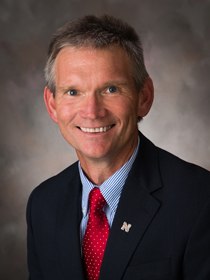
SNR continues to make enormous progress both in terms of our Land Grant missions and as the SNR family. This past year, we have continued our move to streamline the school, and we now will focus on three Mission Areas: Applied Ecology; Environmental Sciences, which includes water, soils and geology; and Climate and Spatial Science, which includes remote sensing. We are actively looking at our majors and will move toward streamlining them in the near future to create an identifiable SNR brand.
We had a great year in hiring new faculty, several jointly with other programs in the Institute of Agriculture and Natural Resources. In 2016, we added a new One Health Coordinator, Elizabeth Van Wormer, who has been in Lincoln; her position will be split with Veterinary Medicine. Jamilynn Poletto, a fish biologist, joined our fisheries team in August, and John Gamon, a remote-sensing expert, also joined our team that month to serve as assistant director of the Center for Advanced Land Management Informational Technologies. Gamon will coordinate the school’s airplane remote-sensing program as part of his post. The University of Nebraska-Lincoln is emphasizing team science, and our newer faculty are at the center of that initiative. It is great to see them raising the energy within the school.
Looking ahead, John Benson will start as SNR’s vertebrate ecologist in January, and Tiffany Messer, a water engineer mainly housed in Biological Systems Engineering, also will join us that month. Eric North will join SNR as a professor of practice to initiate our urban and community forestry program starting in April 2017, and Judy Turk will join us in summer 2017 as our new pedologist or soil scientist. As the year unfolds, we’ll continue working to fill several other faculty and staff positions within the school to continue growing our program.
Our research faculty continues to generate enormous grant funding, and we again are in the $10 million range for grants and contracts. The outcome of those grants are significant numbers of publications and books, as well as the molding of graduate students and their research.
We’ve also created a renewed emphasis on Extension in SNR. This year was the start of our Extension members following the Nebraska Extension model of outreach and education. Two of our Extension faculty, Dennis Ferraro and Katie Pekarek, are leading efforts to create a more effective SNR Extension team.
With recent budget instability across the Midwest, we have been working hard to be more efficient with our state budget, but more importantly, we’ve moved toward recruiting more heavily in adjacent states to take advantage of significant cuts being made to university natural resources programs there. We have seen increase in interest in our programs from students in Minnesota, and we plan to target Illinois heavily in the upcoming months.
Finally, there is a great deal of uncertainty in the world, but the bottom line is that natural resources research and education are cornerstones to help us solve the many problems facing the human race. From the bedrock to the sky, the importance of our work will only increase.
John Carroll, director